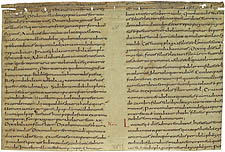9th Century
![]()
The graceful script in this fragment (which was recovered from the binding
of a book) is an example of handwriting that was developed during the
Carolingian Renaissance. It is identified by paleographers as "Caroline
minuscule," since it was fostered during the time of Charlemagne
(Carolus Magnus in Latin) and because it used letters that were
smaller (minus) than the exclusively capital letters employed
by the ancient Romans. We call these letters "lower case" because
printers used to keep the type for minuscule characters in a lower case
and the type for capital letters in an upper case. Modern print, in fact,
is ultimately based on the revolutionary form given to the Roman alphabet
during the time of Charlemagne. Minute details enable us to identify Tours
as this manuscript’s place of origin.
![]()
Bible Fragments, Book of Numbers. France (Tours), 9th century.
![]()

Copyright
© 2002 Division of Rare & Manuscript
Collections
2B Carl A. Kroch Library, Cornell University, Ithaca, NY, 14853
Phone Number: (607) 255-3530. Fax Number: (607) 255-9524
For
reference questions, send mail to:
rareref@cornell.edu
If you have questions or comments about the site, send mail to: webmaster.
